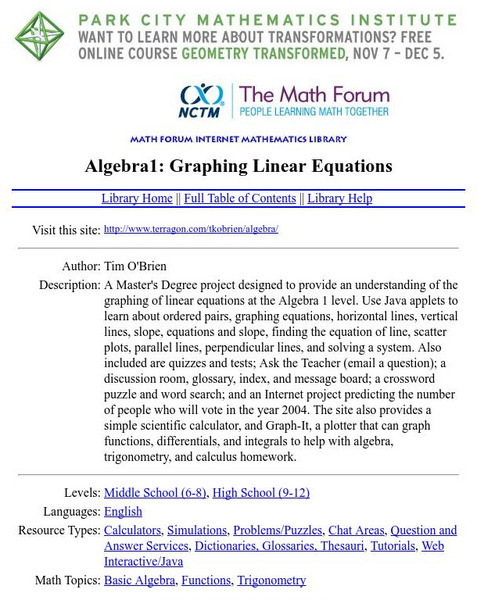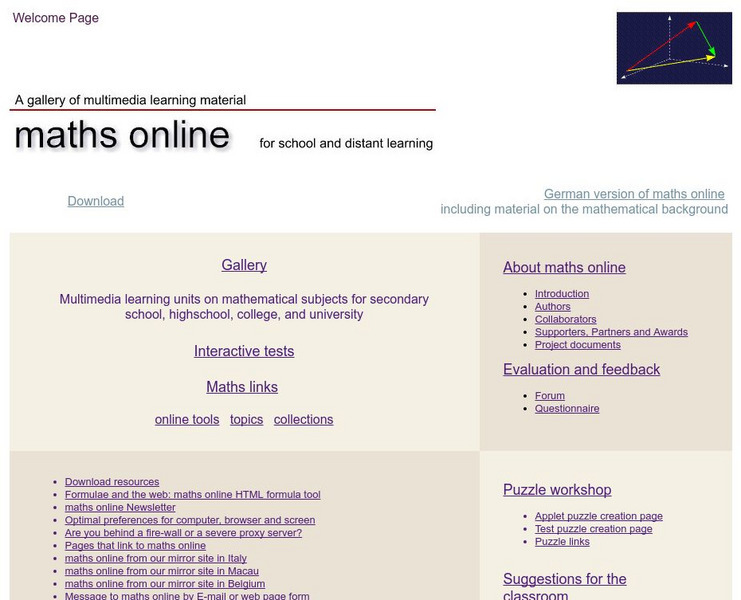Curated OER
Bus Graph
Students make predictions about which bus takes the most/least students in the classroom. They use KidPix bus stamp for each student who goes home on that bus number and record data and discuss predictions.
02 x 02 Worksheets
Factoring
Factor in this resource when teaching how to factor polynomials. Scholars use algebra tiles to factor linear and quadratic expressions. They practice their skill by working on example problems from a worksheet.
Curated OER
The Ice Cream Stands Problem
Tenth graders pretend to set up an ice cream shop in a make believe town of shapes. In this geometry lesson, 10th graders work together to put up an ice cream stand in an ideal location and solve for the minimum given the...
Curated OER
Does the falling tree make a sound if no one if there to hear it? (or communication via encryption)
Students explore encryption. They discuss the importance of cryptography in our daily lives. Students use games and cryptography to discover transformational geometry and modulo systems. They design their own encryption puzzles and...
Curated OER
Mine Shaft Grade 8 Slope
Eighth graders investigate slopes using real life scenario. For this algebra lesson, 8th graders model and interpret real life data. They plot their data in a coordinate plane and discuss the results with the class.
Curated OER
Can You Identify Arthropods?
Third graders sort and classify the four Arthropod classes. They are given puzzle pieces of one Arthropod example. Each group is to put their puzzle together, glue it on a piece of construction paper and label the ir puzzle.
Curated OER
Creating a Mathematical Model Using Weather Data
Students explore the concept of mathematical models. In this mathematical model lesson, students create a mathematical model from data from 4 cities over 15 months. Students are told they are working for a weather station. Students...
Curated OER
Intuitive Approach to Limits
Students view examples of art work that illustrate limits in calculus. Students will lecture on limits and then complete practice drill. This lesson does not include a defined procedure or practice problems. All the art links work but...
Curated OER
Analyzing Cubes
In this analyzing cubes activity, 9th graders solve and complete 6 different types of problems. First, they organize the given data into the table provided. Then, students study the patterns in the table and tell whether the pattern of...
Curated OER
Architecture of the Skeleton
Students experiment with skeletons. In this bone health lesson, students analyze, construct, and perform comparative investigations with bones. They make inferences about the structure and function of various bones. This lesson includes...
Curated OER
Constructing Tangrams
Seventh graders visualize and identify geometric shapes after applying transformations on a coordinate plane. In this tangrams instructional activity, 7th graders construct a set of tangrams and then answer extension questions related to...
Curated OER
Problem Solving Using Pattern Blocks
Students use pattern blocks to create a figure that is described to them and establish a pattern based on the description of the geometric figure. In this pattern blocks lesson plan, students fill out shape and fraction worksheets.
Curated OER
Right Angles--Algebra Vocabulary
In this secondary mathematics worksheet, students create a crossword review of algebra vocabulary. The students must determine the correct answer to each clue and then determine the correct placement for the term in the 12 by 12...
Curated OER
Honey ! I Blew Up The Bee!
Second graders complete a variety of bee-themed activities. They consider the importance of honeybees in food production, conduct Internet research, prepare foods using honey, complete puzzles and compile a portfolio of their work.
Curated OER
Kincaid Creatures
Students brainstorm a list of nocturnal and diurnal wild animals they see in their community and discuss how the animals would be different if they were living during the Ice Age. Using a handout, they discover how archeologists record...
Curated OER
Drawing Conclusions
Students play a probability game, then design and complete a probability problem concerning changing odds.
Curated OER
Tourism in London
Learners discuss the tourist attractions that are in London. They examine how data can be manipulated by completing a worksheet. They plan a trip to a London attraction after conducting Internet research.
Curated OER
Multiple Intelligences Survey
In this multiple intelligences activity, students complete a survey asking them about different ways they like to learn. Students complete 24 questions. This should be a very enjoyable activity for students.
Curated OER
Lesson plan: History Underfoot
Students study Native Americans of Virginia. In this Virginia history lesson, students take on the role of archaeologists as they analyze a site and its artifacts. Students use the information to draw conclusions about the natives who...
Curated OER
It's A Jungle Out There!
Students report on an animal according to its appearance, habitat, and characteristics.
National Council of Teachers of Mathematics
The Math Forum: Graphing Linear Equations
This site from The Math Forum provides chat areas, simulations, JAVAapplets, problems, answers, puzzles, quizzes and tutoring! Links are also provided for additional information.
University of Vienna (Austria)
University of Vienna: The Big Function Graph Puzzle
Interactive matching game where linear and quadratic expressions are matched to their associated functions graphs. Site features over 100 graphs, although only six are used at one time.
University of Vienna (Austria)
Math Online: Functions
This interactive site uses applets to show sample graphs of each simple power function, a function plotter, graph puzzles, and more. Great site.
University of Vienna (Austria)
University of Vienna: Maths Online
The University of Vienna, Austria, created this site to help bring the worlds of math and technology together. You have access to many applets and downloads that allow you to create lessons, tests, and puzzles. There are also great...























